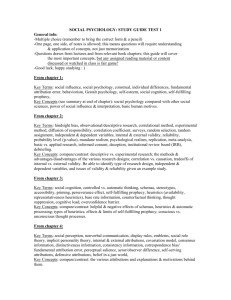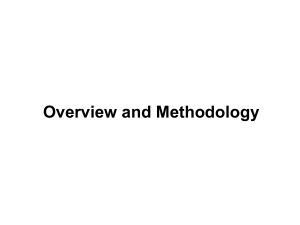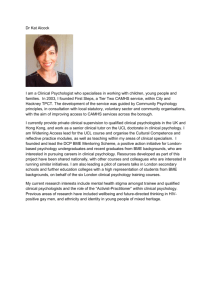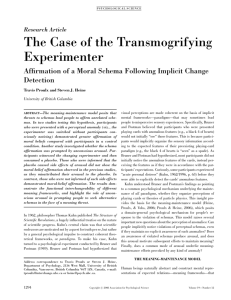Exam 1 Psychology 360
advertisement
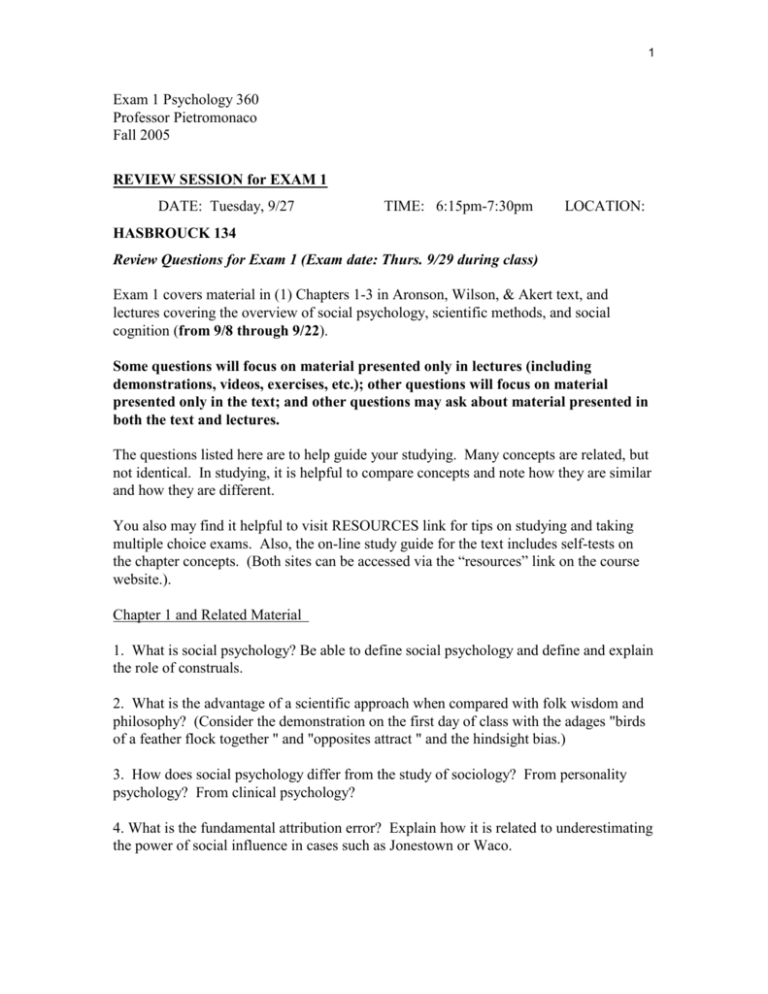
1 Exam 1 Psychology 360 Professor Pietromonaco Fall 2005 REVIEW SESSION for EXAM 1 DATE: Tuesday, 9/27 TIME: 6:15pm-7:30pm LOCATION: HASBROUCK 134 Review Questions for Exam 1 (Exam date: Thurs. 9/29 during class) Exam 1 covers material in (1) Chapters 1-3 in Aronson, Wilson, & Akert text, and lectures covering the overview of social psychology, scientific methods, and social cognition (from 9/8 through 9/22). Some questions will focus on material presented only in lectures (including demonstrations, videos, exercises, etc.); other questions will focus on material presented only in the text; and other questions may ask about material presented in both the text and lectures. The questions listed here are to help guide your studying. Many concepts are related, but not identical. In studying, it is helpful to compare concepts and note how they are similar and how they are different. You also may find it helpful to visit RESOURCES link for tips on studying and taking multiple choice exams. Also, the on-line study guide for the text includes self-tests on the chapter concepts. (Both sites can be accessed via the “resources” link on the course website.). Chapter 1 and Related Material 1. What is social psychology? Be able to define social psychology and define and explain the role of construals. 2. What is the advantage of a scientific approach when compared with folk wisdom and philosophy? (Consider the demonstration on the first day of class with the adages "birds of a feather flock together " and "opposites attract " and the hindsight bias.) 3. How does social psychology differ from the study of sociology? From personality psychology? From clinical psychology? 4. What is the fundamental attribution error? Explain how it is related to underestimating the power of social influence in cases such as Jonestown or Waco. 2 5. Describe the Ross and Samuels’ (1983) study. What was the independent variable? What was the quasi-independent variable? What was the dependent variable? Summarize the findings. 6. Compare and contrast the perspectives of psychologists from each of the following approaches: Behaviorism, Gestalt psychology, social psychology. (What are the similarities and differences between these approaches?) 7. Your text discusses two basic human motives that are important in explaining human thought and behavior. What are these two motives? Explain how each motive is related to thought and behavior. 8. How do social psychologists differ from philosophers, novelists, and political pundits in answering questions about human nature? Chapter 2 and related material 9. Explain Latane and Darley's notion of diffusion of responsibility. What was their hypothesis? In their "seizure" study, what was the independent variable? What were the dependent variables? What did they find? 10. What is the observational method? Explain the nature of archival analysis, which is a form of the observational method. What are the limitations of this method? What are its advantages? 11. What is the correlational method? Explain what a correlation coefficient is, and how it is expressed as a number. Explain the difference between a positive correlation, and negative correlation, and no correlation. What kind of number would indicate a strong correlation? A moderate correlation? A small correlation? No correlation? 12. According to lecture, what are three possible interpretations for correlations? (Hint: Pay attention to direction of causality and third variables.) 13. What are the limitations of the correlational method? What are the advantages of the correlational method? 14. Why do social psychologists prefer to use the experimental method? 15. A. What are the necessary components of a controlled laboratory experiment? (Be sure to define and explain the following terms: independent variable, dependent variable, internal validity, random assignment to condition, probability level (p-value), external validity, mundane realism, psychological realism, cover story, replication). Note: Random assignment is different from random selection of a sample. Comparing and contrasting these terms will help you to understand the difference. 3 B. You should be able to read a description of a study and identify the independent variable and the dependent variables. 16. How do social psychologists eliminate sources of bias in controlled experiments? Refer to the role of random assignment to conditions, controlling for experimenter bias, and controlling for participant bias. 17. Define the term " confounding variable." 18. What are the limitations of controlled laboratory experiments? What are their advantages? 19. What is a meta-analysis and why is it used? 20. How is the idea of self-fulfilling prophecy related to the effect of experimenter expectations on participants ' responses? 21. What safeguards are used in social psychological research to protect human participants? Explain the procedures of informed consent, deception, and debriefing. Recall the Simpson video clip and why Lisa’s experiment on Bart and her hamster was not ethical. 22. What is the primary goal of cross-cultural research in social psychology? Why is cross-cultural research hard to do? 23. What is the role of deception in social psychological research? Some researchers have studied how people feel after participating in deception versus nondeception experiments. What does this research show? Chapter 3 and related material 24. What idea was investigated in Rosenthal and Jacobson’s study on teacher expectations? What were the findings? 25. Compare and contrast automatic versus controlled processing. 26. What is the focus of the area called social cognition? 27. What is a schema ? What are the functions of schemas? 28. Which schemas are applied? What is the role of the accessibility and priming? Know the findings of the studies by Higgins, Rholes, & Jones (1977, text p. 66 and lecture) and Bargh and Pietromonaco (1982) (text, pp. 66-67). 4 29. Do schemas persist even after they are discredited? Answer this question referring to the study by Ross, Lepper, & Hubbard, 1975 on "belief perseverance” (suicide note detection task). 30. The Silver Creek restaurant story with Bob and Jane (lecture) included a variety of events that happened while Bob and Jane were in a restaurant. You later answer “true” or “false” to sentences describing events that either occurred or did not occur in the story. This exercise demonstrated what feature of schematic processing? 31. Define self-fulfilling prophecy, and explain how it is relevant to the work by Rosenthal and Jacobson (on teacher expectations). 32. In a study (Snyder & Swann, 1978) discussed in lecture, participants selected questions for an interview with the person they expected to be either extroverted or introverted. What were the findings of this study? How do they relate to schematic processing? 33. According to your text, two kinds of schema accessibility are temporary accessibility and chronic accessibility. Define each of these terms. 34. In the demonstration conducted by David Rosenhan, he and several colleagues pretended that they were hearing voices and were admitted to psychiatric hospitals; most were diagnosed with schizophrenia. Except for the one symptom, the pseudopatients behaved in a completely “normal” manner and reported their actual life histories. According to lecture, what role did the schemas held by the staff play in their interpretation of the pseudopatients' behaviors? 35. What is a judgmental heuristic? How is a heuristic different from a schema? 36. Define and give examples of the following: the availability heuristic, the representativeness heuristic, and counterfactual thinking. Also, explain the relationship between the representativeness heuristic and base rate information. 37. What were findings of the study by Hamill, Wilson, and Nisbett (1980) (study using a description of a welfare mother and base rate information) described in lecture? What was the main point of this study? 38. Describe Dan Wegner's theory of ironic processes and thought suppression. Explain the two processes that operate in thought suppression. Under what conditions will people have difficulty suppressing unwanted thoughts? 39. What steps might improve human reasoning abilities? In particular, according to Richard Nisbett and colleagues, what kind of training seems to improve everyday reasoning abilities? 5 40. In class (Tues., 9/ 20) I read a story about putting things into piles, etc. Before you had the label for the activity, most students didn’t know what it was and could not remember much of the story. After you had a label, you were better able to follow the story and remember it. What was the point of this demonstration? 41. In an experiment by John Bargh and colleagues discussed in lecture, participants were primed with words related to being polite, rude, or neither (i.e., neutral words) and later they had to interrupt the experimenter in order to complete the next task. The researchers assessed how long it took people in each condition to interrupt the experimenter. Know the results of this experiment and what concept it demonstrates. 42. As described in your text, how is the Amadou Diallo case related to the idea of automatic processing? 43. In a study by Correll et al. (2002) described in the text, people played a video game in which they saw white and black people holding either a gun or a cell phone, and had to press either a “shoot” button or a “don’t shoot” button. What did they find? People holding which kind of belief(s) were MOST likely to have a “shooter bias”? 44. According to your text, how might girls’ poorer performance on standardized tests be explained in terms of the self-fulfilling prophecy? Be sure to explain the role of teachers. 45. Explain how each of the following increase the likelihood that schemas resistant to change: perseverance effect, self-fulfilling prophecy, reconstructive memory. 46. Why do schemas differ from culture to culture? 47. In an experiment by Allan Harkness and colleagues (1985 – see your text), some women were led to believe that they might date a man named Tom for several weeks and other women did not expect to have any future contact with Tom. What were the findings of the study? Explain how the findings relate to the concept of controlled processing.
